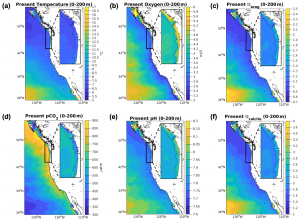Increased carbon emissions have warmed and acidified oceans and caused shifts in ocean current systems, threatening marine ecosystems and the people connected to them. The North Pacific Ocean in particular is expected to experience some of the largest changes in ocean conditions by 2100. Until now, little was known about how coastal processes—those oceanic processes that occur near the coast—can modify these projections.
A newly published paper in the journal Biogeosciences aims to remedy this. A multi-disciplinary team from the University of Washington (UW) and National Oceanic and Atmospheric Administration (NOAA) developed a new multi-model to project how processes that occur in the coastal ocean—such as upwelling, freshwater delivery, eutrophication, water column metabolism, and sediment interactions— alter the rate of change in the California Current System (CCS).
The team layered regional models with the Coupled Model Intercomparison Project 5 from the World Climate Research Programme to simulate multiple climate-associated stressors, including temperature, O2, pH, saturation state, and CO2, to create 100-year projections in the northern CCS. They used this “multi-model ensemble” to determine the degree to which changes in these stressors will be larger or smaller than those projected by global models. Findings are organized by the regions of coast that represent different ecological habitats.

While the projected changes are consistent with the overall global predictions of a warmer, more acidified ocean with higher carbon content and lower oxygen concentration, the model showed that the magnitude and spatial variability of the change differs when coastal processes are considered. The size of the difference depends on the specific variable.
Samantha Siedlecki, the lead author of the paper, is an assistant professor at the Department of Marine Sciences at the University of Connecticut. She led the study while working at the University of Washington.
“While the direction of change for ocean conditions remained the same as the prior projections (more carbon leads to a decrease in pH for example), it was still surprising to see how the magnitude of the carbon variables were impacted by the new projections. For example, the model shows that pCO2, the partial pressure of carbon dioxide, and other carbon variables are likely modified by the processes that occur on the ocean shelf or drop-off point between the coast and the deep ocean,” said Siedlecki. “The results are quite different for the different variables, and each must be accounted for properly in order to adequately project the magnitude of future carbon conditions in the CCS.”
This work is part of a larger project led by the Washington Ocean Acidification Center (WOAC) and sponsored by the Schwab Charitable Fund and the generosity of Wendy and Eric Schmidt.
According to Terrie Klinger, co-director of WOAC, “The modeling work led by Dr. Siedlecki advances our understanding of how coastal ecosystems could change in the future. The findings are critical to a new analysis, now underway, that seeks to understand how future changes in ocean condition will affect biological communities, including fish and invertebrates of commercial importance along the west coast.”
Jan Newton, co-director of the WOAC, also contributed to the paper. Other co-authors include Darren Pilcher and Emily L. Norton, UW CICOES; Evan M. Howard, Curtis Deutsch, Parker MacCready and Hartmut Frenzel, UW School of Oceanography; Richard A. Feely and Simone R. Alin, NOAA Pacific Marine Environmental Lab.
For more information, contact Samantha Siedlecki at samantha.siedlecki@uconn.edu.
